14 Best Spreadsheet Software Solutions in 2025 (Free & Paid)

Sorry, there were no results found for “”
Sorry, there were no results found for “”
Sorry, there were no results found for “”
Whether working in finance, software development, or fashion, all project managers face the same challenge at some point—representing and managing data. The bigger and more complex a dataset is, the harder it is to handle.
This is where spreadsheet software solutions step into the spotlight. With their customizability and versatility, these tools make handling figures and values a breeze. Besides providing a space for entering and sorting data, they help you calculate it with formulas.
There are a lot of spreadsheet tools on the market, and finding the perfect one can be challenging. We went through dozens of options, analyzed their main features, advantages, and drawbacks, and hand-picked the 14 best spreadsheet software for streamlining your data management and other PM-related processes!
There are certain key characteristics your next spreadsheet software solution should have, such as:
We used the criteria discussed above to compile a list of the top 14 spreadsheet platforms that offer the most value. These platforms combine reliability, ease of use, and functionality and can be used in any industry. 💪

ClickUp is a comprehensive project management platform. One of its many uses is creating clean, well-organized, and collaborative spreadsheets and databases, all thanks to ClickUp Table view.
This view lets you design functional spreadsheets for managing documents, projects, clients, and your team. Thanks to its 15+ views, you can represent and work with any data type, from formulas and task progress to costs, prices, and ratings. You can up your spreadsheet game by attaching documents and links to your table.
ClickUp helps you manage your data by letting you create relationships between tasks, thus ensuring optimized workflows and determining priority. You can connect clients to specific projects and team members to bug reports and establish task dependencies.
The platform also offers fantastic spreadsheet templates that make your work easier. Try ClickUp’s Project Management Spreadsheet Template to break down your project into tasks, add assignees, track phases, and monitor deadlines.

Easily one of the most popular spreadsheet programs ever, Microsoft Excel offers an array of features for storing, manipulating, and visualizing data.
You’ll be most interested in the formula bar located above the columns. This is where you tell Excel what kind of math you want it to do. The tool offers 450+ formulas for handling data, the most popular ones being SUM, IF, COUNT, MAX, and AVERAGE.
Sounds complicated? Don’t worry because Excel explains every formula in detail. Plus, it directs you on how to use it, and if you make a mistake, Excel will inform you about it by displaying an error value like #####, #DIV/0!, or #NAME?.
Excel is also fantastic for visualizing your data with charts and graphs. You only need to select the desired data and let the program do its magic.
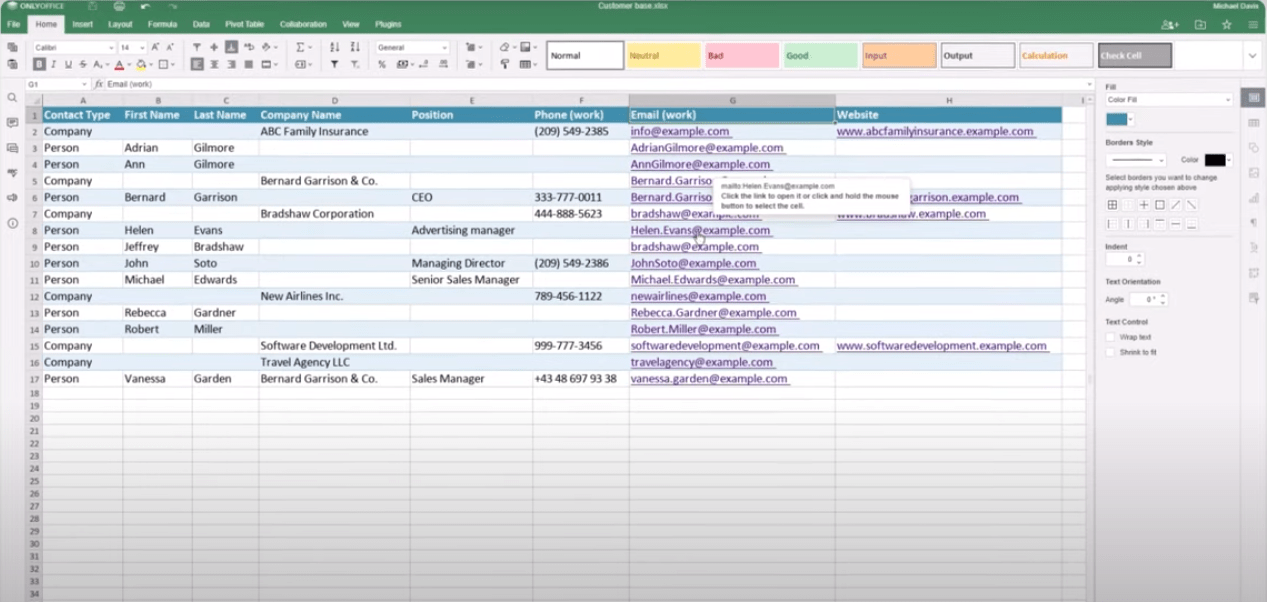
OnlyOffice has an Excel-like interface and even lets you upload and edit Excel spreadsheets. The platform allows real-time editing, which ultimately leads us to its main benefit—collaboration.
OnlyOffice lets you and your team work on spreadsheets together, leave comments, and chat to ensure everyone’s in the loop regarding the project’s latest twists and turns. You can also browse version history and retrieve specific info.
The platform gives you spreadsheet superpowers with 400+ formulas and functions. Use table templates to make your work easier, analyze data with Pivot tables, visualize info with graphs and charts, insert files, password-protect your sheets, automate tasks, save sheets as PDFs, and much more!
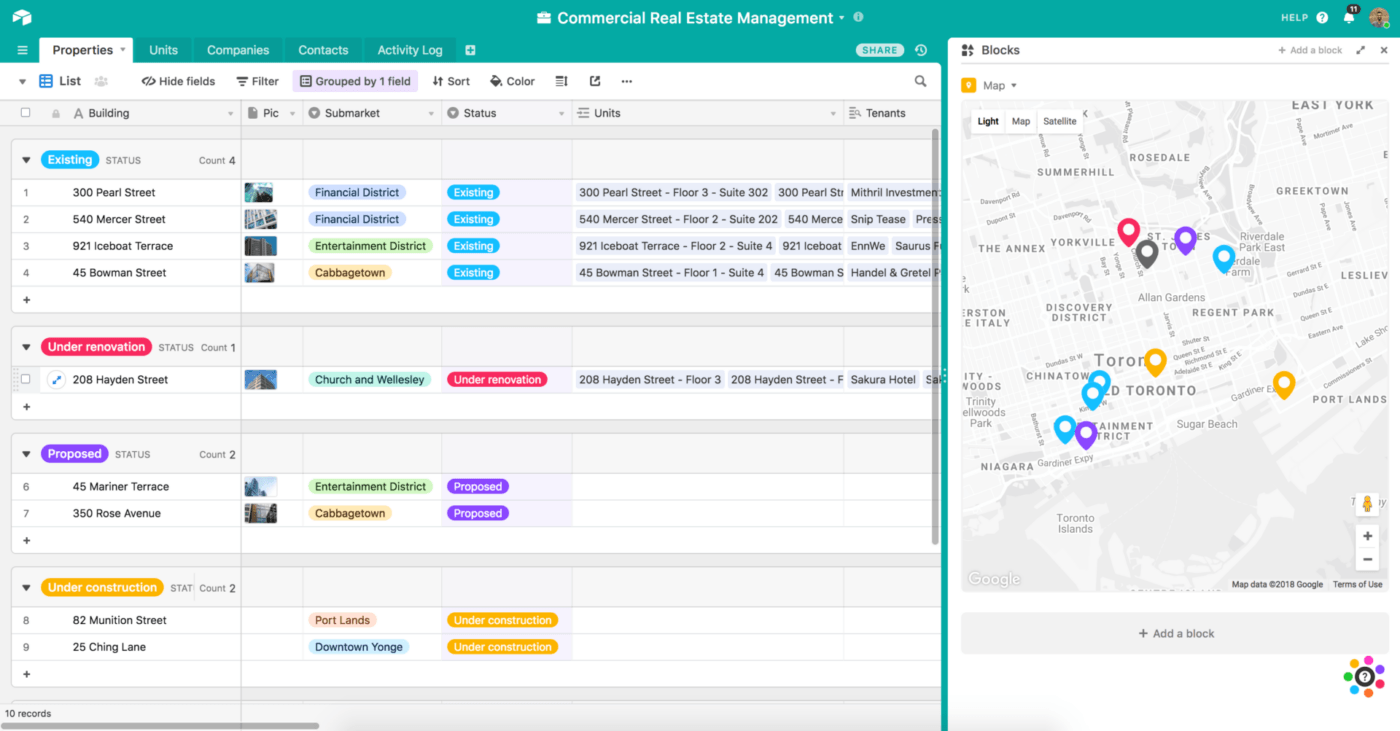
Want to mix the good old spreadsheet look with the functionality of databases? Grab a seat at one of the best free spreadsheet software, Airtable!
Airtable has a spreadsheet-like interface with grids of columns and rows. But, the platform is more than spreadsheet software—it revolves around databases.
You can connect your Airtable databases to external tables, accommodate all kinds of file types and sizes, isolate data subsets, and look at data from different viewpoints, all the while maintaining data integrity.
Airtable is an excellent platform for collaboration since multiple people can edit and manage databases simultaneously. You can enjoy the standard spreadsheet software options like creating graphs, charts, and pivot tables from your data, performing calculations, and filtering information.
*All listed prices refer to the yearly billing model

What do you get when you mix a project and work management platform with spreadsheets? You get Smartsheet, a versatile program with a signature grid interface.
Entering data is easy, and you can add custom columns and rows to create a space that matches your company’s needs to the letter.
With Smartsheet, you can generate project-related reports right from its Grid view. Automate tasks, collect data through forms, create task dependencies, and use templates to make your work smarter instead of harder!
The Grid View supports numerous column types like contacts, dates, and symbols. It lets you attach documents and use row hierarchy and conditional formatting to organize your data. This view is adaptable to multiple scenarios, from managing projects and clients to ensuring compliance and reviewing client feedback.
You can use Smartsheet to analyze workflows and processes to determine your team’s efficiency and plan future endeavors with confidence.
Compare Smartsheet Vs Asana!
*All listed prices refer to the yearly billing model
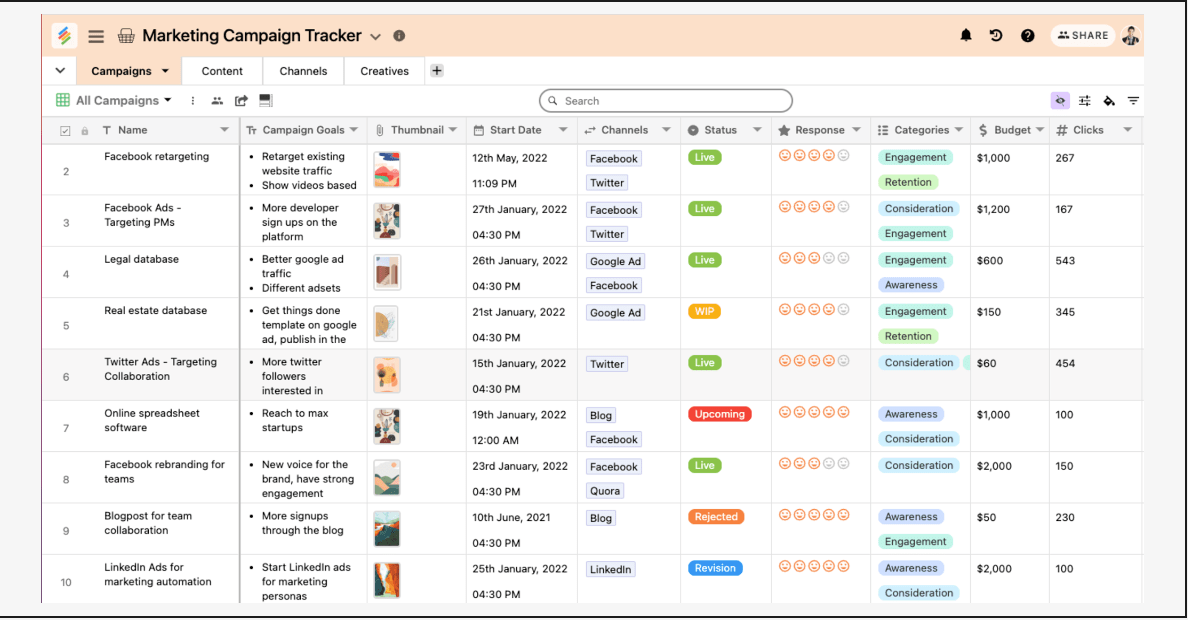
Want a spreadsheet-database hybrid that emphasizes collaboration and lets you create and automate workflows?
Stackby relies on no-code databases with a familiar spreadsheet look. You can use it like a regular spreadsheet platform—enter data, calculate, and create reports. But, with Stackby, you can also turn your spreadsheet into a robust no-code relational database.
The platform lets you collect data through forms and offers views like Grid, Kanban, and Calendar. Use 25+ column types, connect your tables, and leverage conditional formatting and advanced filtering options.
The best part is you don’t have to update your data manually—simply connect your tables to APIs and let the database do the work for you.
Based on the data in your databases, you can build dashboards with visuals like graphs, charts, or goal trackers.
*All listed prices refer to the yearly billing model.
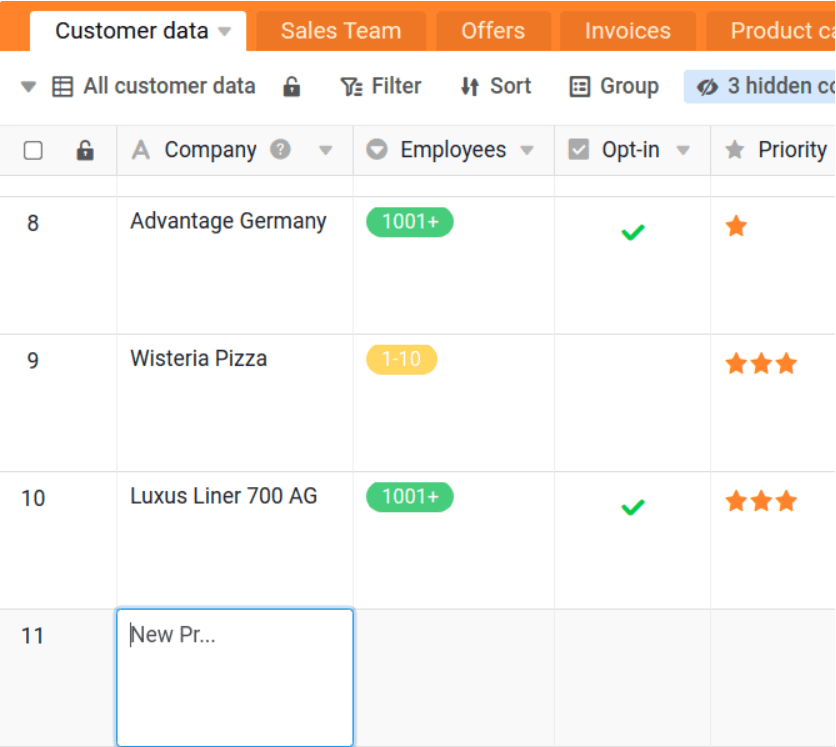
Another database-spreadsheet combo, SeaTable is packed with features that make organizing and manipulating data feel like a day at the beach!
SeaTable lets you enter new data using forms, API, or integrations. It supports all kinds of data, from text, dates, and numbers to images, emails, files, and URLs.
You’re in complete control of everything going on in your database. You can filter data, customize permission settings, edit colors, switch between views, share work with coworkers and third parties, and turn your data into charts and graphs.
SeaTable also offers impressive automation options. Optimize repetitive tasks using scripts in Javascript and Python, make calculations across all rows and columns (like in Excel), create customized notifications for certain actions, and execute specific processes at scheduled times.

Think of Quip as a dynamic fusion of spreadsheets, documents, and chat options. It blends together powerful features for streamlining sales processes and boosting real-time collaboration.
Being a Salesforce subsidiary, it’s no surprise you can get all Salesforce lists, data, and reports directly from Quip, ensuring you’re working with the latest info.
With Quip spreadsheets, you can manage your sales and CRM data, share it with coworkers and clients, perform calculations, automate processes, and take advantage of templates and integrations to make your work even easier. Permission settings let you decide who can do what in which spreadsheet.
The platform is equipped with 400+ functions and shortcuts to help you and your team get more things done in less time.
*All listed prices refer to the yearly billing model.
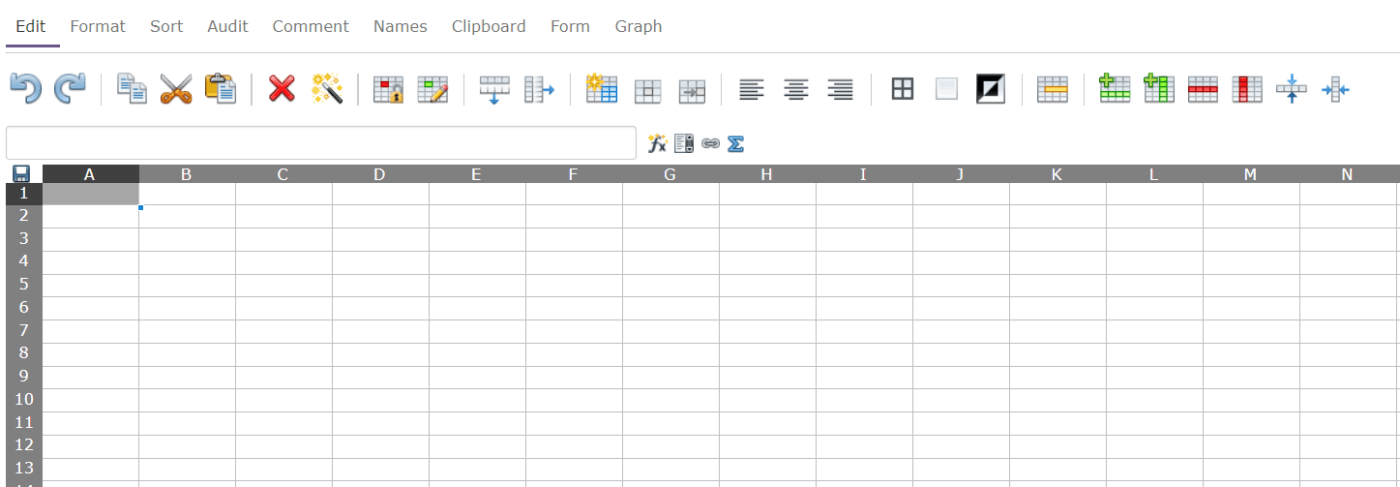
A simple, web-based, free spreadsheet software that doesn’t require creating an account might sound like a dream. EtherCalc makes it a reality!
All you need to start using the platform is to visit its website. Once you create your spreadsheet, you can share it with others and work together in real time.
This isn’t a robust database platform that lets you automate tasks, connect sheets, or integrate with other programs. It is a simple spreadsheet platform with a clutter-free interface, perfect for those who don’t need bells and whistles.
EtherCalc is ideal for inventory management and creating survey forms, but it can also come in handy for brainstorming sessions.
It lets you import .csv, .ods, and .xlsx files and use different column types like text, math, date & time, depending on the data you want to represent. You also have dozens of formulas to choose from and manage your data like a pro!
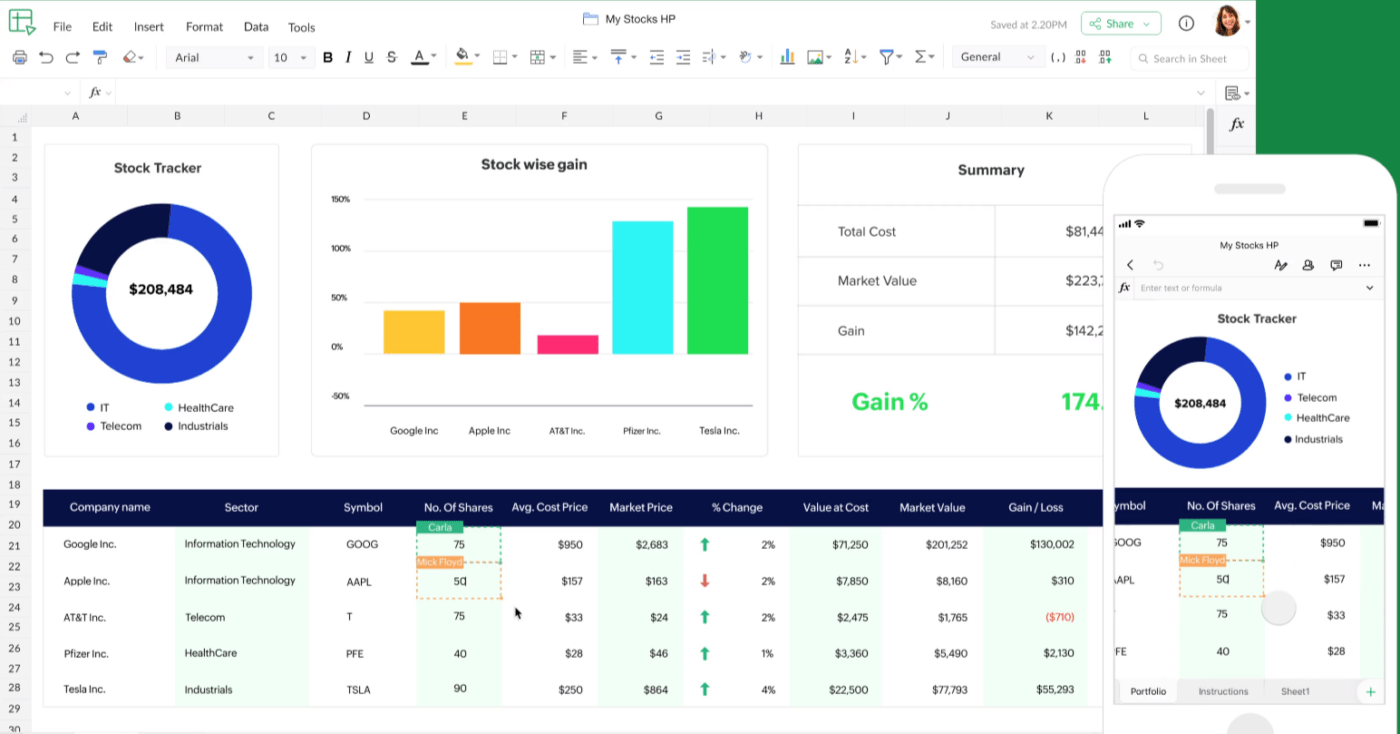
Coming from Zoho, a comprehensive software suite for businesses, Zoho Sheet lets you create and manage functional spreadsheets and work on them with your team.
The platform packs over 350 pre-defined functions, allowing you to manipulate various data types for any purpose, whether doing inventory, planning a budget, or completing a project-related task.
With 1,000+ integrations, Zoho Sheet lets you automate your spreadsheets and import data from various sources, including Excel.
The software prioritizes collaboration, so you can work on spreadsheets with coworkers and comment, make changes, and discuss tasks and projects within them. You can keep control of every spreadsheet by blocking cells for selected collaborators, setting permissions, and reviewing previous versions.
Zoho Sheet has a revolutionary feature—an AI assistant named Zia. Zia is there to answer all questions regarding your data and spreadsheets, and the best thing is it understands plain English!
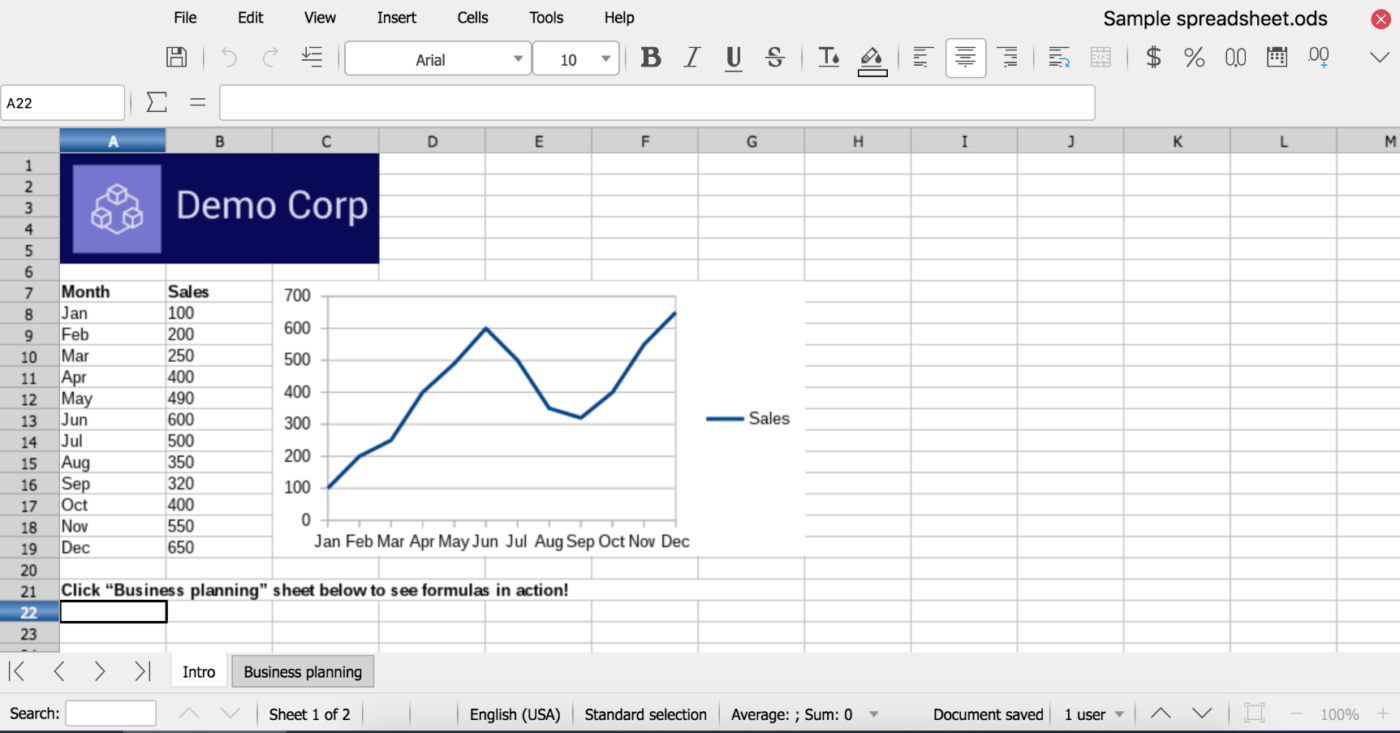
LibreOffice is a free, offline office suite, and many users see it as an excellent alternative to Microsoft Office. The spreadsheet program within the suite is called LibreOffice Calc.
The platform offers 300+ functions for managing small and large datasets, and if you don’t know how to use some of them, the built-in wizard can help.
The feature that stands out is DataPilot. It lets you pull raw data from different databases and turn it into meaningful info you’ll present in your spreadsheet.
Although it’s an offline program, Calc boasts multi-user support. Share your spreadsheets with others, allow them to enter their data, and minimize the risk of miscommunication and data duplication.
By default, Calc saves documents in the .odt format. But with many people still using Excel, Calc lets you keep your spreadsheets in the .xlsx format! You can also export spreadsheets to PDFs.
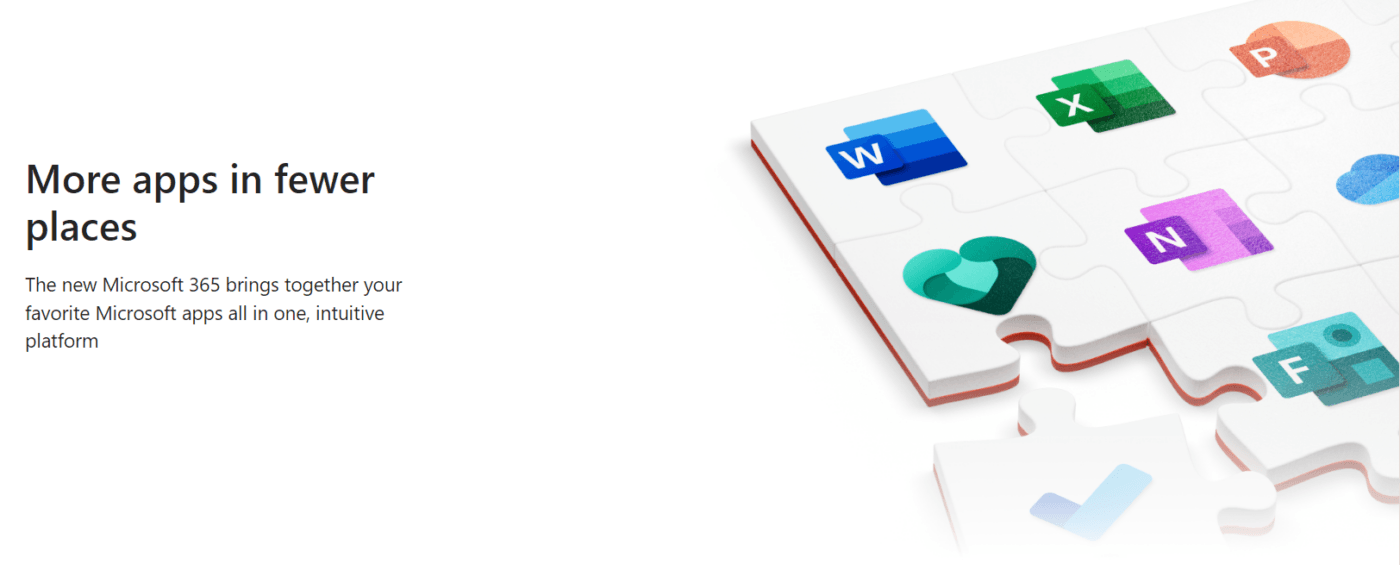
Microsoft 365, formerly known as Office 365, is a software suite consisting of popular programs like Excel, Word, PowerPoint, Outlook, Teams, and OneDrive. While Excel is often synonymous with spreadsheets, other applications within the Microsoft 365 family can also help you create and handle spreadsheets, although that isn’t their primary purpose.
For example, if you’re working on a Word document and need to add a spreadsheet to it, you don’t have to launch Excel. Instead, you can insert an Excel spreadsheet, enter your data, and use Excel’s functions directly from Word!
You can do the same in PowerPoint and enrich your presentations with Excel spreadsheets.
When you add an Excel spreadsheet to Word or PowerPoint, Excel’s toolbar appears at the top of the screen, giving you full access to the program’s functions and formulas.

Google Sheets is another widely-used spreadsheet platform with an Excel-like interface.
The platform offers an array of formulas and functions that let you manipulate various types of data with ease. Since it’s cloud-based, Google Sheets enables real-time collaboration, allowing you to work with your team regardless of location.
The platform is a part of Google’s ecosystem, so you can pull your data from Google Forms or add spreadsheets to your Google Docs or Google Slides.
Another essential quality of Google Sheets is its versatility. You can use it on your computer, laptop, tablet, and mobile device, meaning you can create and edit spreadsheets even when you’re on the go!
Google Sheets automates repetitive entries with Smart Fill—it detects patterns and suggests the most appropriate solutions, which is another convenient and time-saving option.
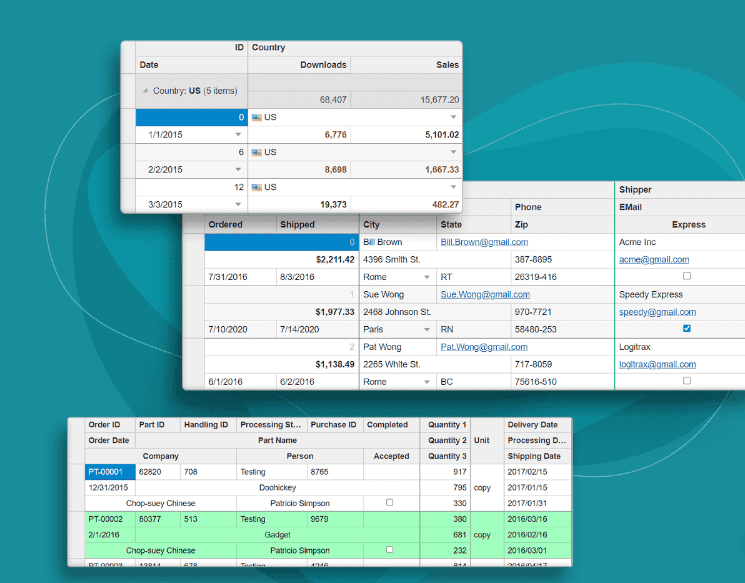
If working in JavaScript, you know the pain of scrolling through wide grids to get the desired information. MultiRow DataGrid helps you customize your grid and choose which columns and rows to display in a stacked format.
Besides giving you flexibility in layout designs, MultiRow lets you group fields based on their hierarchical structure, merge cells, freeze specific rows/columns, and use your keyboard to navigate your grids. You can also use advanced filtering options to get to the right information with ease.
Spreadsheet software solutions can wear many hats—they can be used to plan project goals, create task lists, calculate project budgets, draw charts and graphs, track time, and much more.
The right spreadsheet tool can turn you into a PM superhero and help you and your team handle projects with more efficiency and less stress.
© 2025 ClickUp